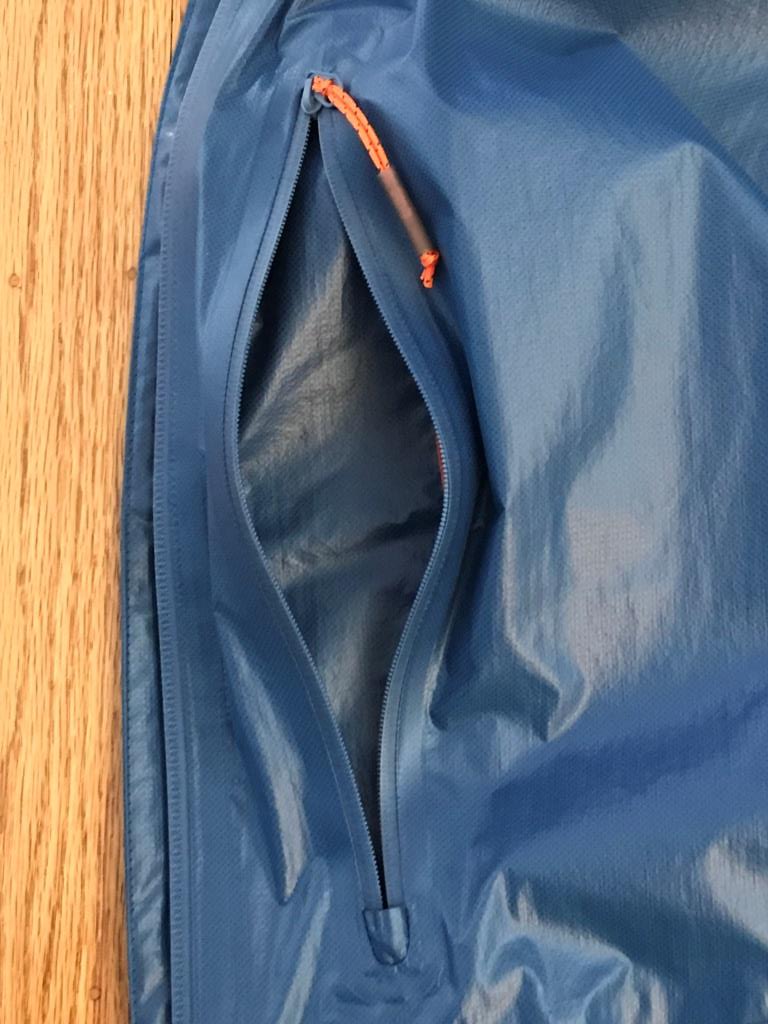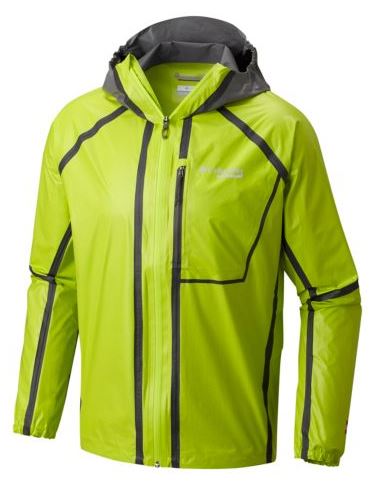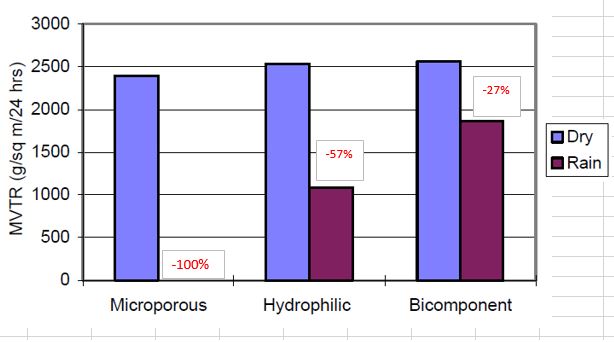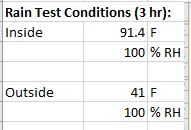Topic
A NEW PARADIGM FOR UNDERSTANDING WPB FABRICS
Forum Posting
A Membership is required to post in the forums. Login or become a member to post in the member forums!
Home › Forums › Gear Forums › Gear (General) › A NEW PARADIGM FOR UNDERSTANDING WPB FABRICS
- This topic has 100 replies, 25 voices, and was last updated 6 years, 9 months ago by
 Eric Blumensaadt.
Eric Blumensaadt.
-
AuthorPosts
-
Feb 25, 2018 at 6:24 pm #3520649
Woubeir,
Yes, I will test the Shakedry’s CFM. It is something I also looked at with the Outdry EX versions.
The Columbia Outdry blog states, “OutDry Extreme is ultra-breathable thanks to microscopic perforations in the membrane that allows moisture to escape while keeping rain at bay”. I measured their membrane at 0 CFM and I can accurately detect down to .01 CFM. That infers that their membrane is bicomponent with a microporous PU layer inside, and an armored hydrophobic layer on the outside.
I suspect you are correct. If ShakeDry could be made durable enough for wear under a backpack, using its current PTFE membrane(s), it would be more comfortable. That is because the internal moisture would vent at a lower internal RH.
Feb 25, 2018 at 7:33 pm #3520659Search for US20160075101A1 and US20140205815A1 ;-)
Feb 27, 2018 at 2:19 am #3520917I wonder if they will release the green color they have in one of the stock photos on the Columbia website, I prefer that to black or navy. I’d love to hear more feedback on the shell, not only the membrane, but the fit and other impressions as well.
Feb 27, 2018 at 4:17 am #3520935Brad,
They have released that stealthy “Gravel” color for their Outdry EX Stretch jacket but not their Outdry EX Featherweight. It is a color I would have selected if it was available.
I have an athletic build and normally wear XL in any vendor’s rain jacket. I feel no binding in the shoulder area when I rotate my elbows completely forward with this jacket. The other Columbia Outdry EX shells, of the same size using the 2x heavier material, bind on me. The one exception is their much heavier Outdry EX Stretch model.
The suppleness of the fabric makes the garment drape as a windshirt would as opposed to a stiff hard-shell. For me, that is a nicer look.
I have tried many of their other models on and on me, they looked like a boxy non-breathable rain jacket.
I have 35″ arms but, the sleeves are long enough I can release the Velcro wrist tabs and pull them over my hands to protect them during rain. I can also open the Velcro and push the sleeves up to ventilate as if it were a short sleeve shirt. I won’t go over any of my bicep, but it will go to just above my elbow. It is tighter than I would like in this mode but it is a doable ventilation feature.
The zippers are all waterproof so I don’t have to worry about wind gusts sometimes blowing a zipper cover away from protection position as I do in some of my rain jackets.
The polyester hydrophilic liner feels like a conventional shirt against my skin. I could wear in that shirt mode if I really needed to minimize heat build-up.
The two pockets / vertical vents are about 7″ wide and 14″ tall. That large size is great for both torso ventilation, drying things out like oversized mitten shells, or carrying large maps.
The hood is minimalistic with only elastic to provide a vertical seal. The horizontal volume is adjustable via an elastic cord and friction retainer. I normally wear my sun visor under the hood to give it the additional rigidity it should inherently have.
The waist bungee is so minimalistic as to be almost nonexistent. There is no adjustable elastic to form a tight seal. There is only a non-aggressive built in elastic along the back. Obviously, that isn’t a problem if you are wearing pack belt. For environments when you want to use it for warmth when static, this is its biggest short-coming.
Feb 27, 2018 at 7:54 am #3520957Thank you kindly Richard for all your work. May I ask a question regarding “venting”?
Underarm- no venting whatsoever. Is that correct?
The front vertical zip vents-must be completely closed when in rain. Is that correct?
So when in rain the only movement of moist heated air from the jacket will be through the material itself plus what is vented out the sleeve /waist /hood holes/gaps. Is this correct. Thank you
Feb 27, 2018 at 6:23 pm #3521079About the activities that generate enough Watts that the MVTR needed exceed adequate breathability for the best WPB fabrics in cold rain: you’re probably right but given the fact that you tested only 4 jackets, generalising this to all fabrics is a daring claim.
Feb 27, 2018 at 6:56 pm #3521086Graham,
Contrary to their current (2/27/18) Web site description, there are no pit-zips.
The front vertical zip vents need not be partially or completely closed when in rain. First, the vertical WP chest vent zippers are relatively stiff which keep the vertical opening uniform. Second, there are 2 1/2-inch-wide WPB material strips on the inside of the vertical vents / pockets to insure no water ingress while ventilating during rain.


The latest version of the US Special Forces L6 (rain coat) has the same vertical vent position and vent size. Natick Labs uses science rather than a Marketing Department to determine garment features; so, I am comfortable that this method of venting has been well researched.
Feb 27, 2018 at 10:02 pm #3521141Woubier,
Your said in part, “…given the fact that you tested only 4 jackets, generalizing this to all fabrics is a daring claim.”
Yes, my conclusion that “no WPB garment currently provides adequate MVTR for a 7 MET activity in >3 hr. heavy rain” statement involves “great risk or danger” to the Outdoor Industry and as a consequence to myself. The manufacturers, retailers, advertisers, and the press that comprise the “Outdoor Industry” have invested large sums to convey conflicting messages to mine.
Their messages are simple ideas that a consumer can easily grasp and then believe it will provide an amazing result. If one or both of these are not possible, they can use marketing and advertising to obfuscate. They can take complex ideas or mediocre results and give them some spin with a few good phrases, convincing diagrams, and guarantees.
If anyone can provide an independent test result that shows any currently commercially available WPB garment (2/27/18), that is warrantied to be worn under a backpack, has sufficient MVTR for a 7 MET activity, in heavy rain (>3 mm drop size) longer than 3 hours, I will amend my original conclusion and credit both the forum poster and the product in my report.
Feb 27, 2018 at 10:55 pm #3521147Richard, I always read your threads & articles, although I don’t always make time to fully understand every detail! Thanks for your work.
So, what’s the bottom line here? What would you buy as a rain shell if you were buying a new jacket today? Does that answer change depending on location, like the PNW, New England or the Sierra?
Feb 27, 2018 at 11:17 pm #3521150Columbia has another jacket with the same material I tested in Outdry EX Featherweight. It is called the OUTDRY EX™ CALDORADO SHELL JACKET. I haven’t tested this jacket and am only parroting the manufacture’s information below:

They claim it is 2 oz lighter than the Featherweight; has permanent gills under the arms for venting; elastic wrist closures and, an adjustable waist bungee.
Feb 27, 2018 at 11:33 pm #3521160Columbia lists both the Featherweight and Calorado jackets on their website. Neither page lists weights.
By description the Calorado is a running shell and the FW is a backpacking shell. Not obvious what the differences between the two are. There is also the Gore R7, which does list a weight for size Large at 118g (4.2oz)…quite impressive.
https://www.columbia.com/mens-outdry-ex-featherweight-shell-jacket-1771191.html
Feb 27, 2018 at 11:46 pm #3521166Richard,
like I said: you are probably right :-). It’s just that I have seen MVTR-claims of 60000 and higher. OK, these are probably figures tested according to criteria which gives the highest result, nomather how unreal that test is to real world conditions. And without knowing the exact test conditions, it will be very hard to show you’re wrong or right. Not that it will mather to readers here.
Feb 28, 2018 at 12:13 am #3521173Steven,
You said, “So, what’s the bottom line here? What would you buy as a rain shell if you were buying a new jacket today? Does that answer change depending on location, like the PNW, New England or the Sierra?”
Yes.
What is does better than any other WPB jacket, durable enough for backpacking, is it never wets out. Wet out occurs on every type of WPB that has an outer fabric. When it occurs, the suface temperature of the WPB will reduce. For example, if it is 70F and the RH is 50% between showers, the surface of a fabric outer WPB jacket will be at ~50.5 F or about 20 degrees colder than the Outdry EX FW. It doesn’t feel good and the breathability starts to reduce.
-If you are in the front country, you can go home and just wash and dry your WPB to restore its breathability if it wets out. Whatever WPB jacket you select will be fine.
-If you are in the backcountry in a location like the Sierras in the summer, the afternoon showers typically only last an hour and then things dry out. Whatever WPB jacket you select will be fine.
-If you are in the backcountry in a location like the PNW or SE AK, you need the Outdry EX Featherweight. Prolonged rain or abrasion stops the DWR from working and I previously gave an example of what this does to the surface temperature. It also begins the progressive degradation of your membrane or coating. Depending on the specific membrane or coating used in your jacket, the breathability will degrade to the point of actually stopping for all WPB options than hydrophilic PU (low breathability to begin with and stays near that level indefinitely). This breathability will not degrade with the Outdry EX Featherweight.
Feb 28, 2018 at 12:32 am #3521178Thanks for your answer and pics Richard. I am using the Lightheartgear sil/pu jacket with the pitzips fully open in the cold rain and so far so good (CAP4 thermal under and, very thin merino tshirt under that)-NO breathability whatsover thru’ the material as you can tell. But I am from a place of temperate climate SE mainland Australia and am still slightly interested in this for milder wet weather. But given my choice of the sil/pu jacket for constant rain you may be able to tell where my thinking is leading. So far 2-3 hours in rain up and down hills (4-5 kms/hr) NOT mountains and the light sheen of moisture on the inner PU (not my skin which in that situation felt “dry” and comfortable) has been manageable. Body all around zip (pits and area on torso and front chest and bit of back area) remained quite dry to the touch.So thanks again. Water beads off beautifully as you would expect and won’t wet out.
Feb 28, 2018 at 12:35 am #3521180Michael,
To make things worse, not only does Columbia not provide weights on their Web site, when I have called their Customer Service department and asked for weights. They were not close to the quoted rate. Ironically in each case, the numbers they gave me were higher than the actual weights in the range of multiple oz.
My prior understanding was that the Gore ShakeDry material was not warrantied for use under a backpack. For biking, they would warranty its use for road biking but not mountain biking. If this warranty restriction has changed recently, please let us know.
Feb 28, 2018 at 12:51 am #3521185Caveat, I have no experience with any of these products and am in no way promoting them. they could be worthless trashbags.
But, I want to highlight an important point within Richard’s post (i.e., effects on “surface temperature”). Wetting out has two implications. The oft cited one is that is negates the vapor transport properties (for what they are worth). The second implication, though, is that you avoid the continuous evaporative heat losses that occur when the fabric does wet out, which is key in environments like the PNW when you are in all day precipitation at cooler temps and wind.
Feb 28, 2018 at 12:53 am #3521186Richard, did they say why they were not warrantied for backpacking? Makes me wonder how durable the outer layer is to continuous gentle abrasion from backpack straps and belt. Clearly there is much more to learn here.
Feb 28, 2018 at 3:16 am #3521221The Gore Shakedry jackets are not intended for backpacking, and I doubt would be covered under warranty, I know there are quite a few reports of people using them backpacking without issue. My guess (without ever using or even touching one) is that they would be OK for on trail backpacking, but not durable enough for any type of bushwhacking.
If the Columbia Outdry EX Featherweight is durable enough for SE Alaska brush then I am impressed.
Feb 28, 2018 at 3:32 am #3521225Michael,
The current ShakeDry material is comprised of two or three layers of PTFE bonded together, The outer FPTE has relatively big pores and inner PFTE layer has relatively small pores. A fluoroacrylate coating is applied to the PTFE membrane in order to render it oleophobic while preserving the microporous structure (similar to eVent but two layers). You may see bigger numbers for microporous PU but during hard rain the MVTR drops to ~0 after 3 hours. A hydrophilic membrane called Dermizax NX typically tests with a big number for the JiS L 1099-B1 test, the MVTR drops to ~47% of this value after 3 hours of hard rain.
I suspect the ShakeDry engineering team opted for a compromise design > 25,000 in exchange for a dual PTFE membrane that would not stop breathing in rain.
The current PTFE material can relatively easilty abrade and loose significant HH. Future versions; who knows? DIY Abrasion Test
Feb 28, 2018 at 5:20 am #3521252Woubeir
You said, “…I have seen MVTR-claims of 60000 and higher…”. Yes, I have seen this number for at least one product, the “Zpacks™ Vertice Rain Jacket”. They originally just announced a number of 60,000 without describing any test conditions. They later revised their MVTR to 56,000+ g/m^2/24hr via JIS L 1099 Method B1.
The Dermizax NX hydrophillic membrane tests in the range of 50,000 to 60,000 on the JIS L 1099-B1 test based on the face fabric. The downside to this technology is the MVTR typically drops to about 47% of this level after 3 hours of hard rain. In addition, you have the big potential temperature drop from wet out.

This chart reflects the MVTR difference after 3 hours of hard rain. The test conditions follow:

Every garment has pluses and minuses. For an environment like backpacking the Sierra Nevada mountains during summer, this garment could be the perfect combination windshirt / rain jacket. The afternoon showers only last about an hour and so the MVTR degradation in rain wouldn’t be a factor. It would be lighter than carrying both a windshirt and UL rain jacket. In contrast, it could be a very bad answer for SE AK or the Pacific NW when you experience many hours of rain on a regular basis.
Feb 28, 2018 at 5:36 am #3521256Richard, I see now that the Outdry and Shakedry are two different material technologies. Clearly still we (or at least I) need to learn more to understand the real world tradeoffs and performance.
For the large pores in the outer PFTE layer, once filled do they retain a material amount of water (i.e., enough to be considered wet out or to result in significant evaporative cooling)?
Feb 28, 2018 at 5:51 am #3521258Michael,
No, the ShakeDry technology will not result in a wet out temperature drop.
It’s surface is PTFE rather than a fabric
Its pores are large only in the sense they are larger than those is the 2nd layer of its PTFE. The top layer pores are much smaller and more numerous than the membrane I discussed in the immediately prior post.
Feb 28, 2018 at 7:00 am #3521263I’m not sure the military L6 zipper is meant primarily as a vent, but rather for pocket access for under layers such as the L7 vest with similar pocket placement. Also the Natick stuff is built by committee as well as science, and with the number of times features have changed, disappeared and been added over the various iterations of PCU and ECWCS garments I’d be hesitant to give them too much credit for intentionality.
I am pretty excited about the featherweight, it is one of the first outdry garments that has a pocket arrangement and cut that looks even remotely appealing to me. As soon as I can find one for $100> this will likely be the first columbia garment I’ve bought in years.
Feb 28, 2018 at 2:06 pm #3521293- Rab’s Flashpoint-fabrichas/had a claimed MVTR of 60000 and Toray Dermizax NX up to 50000.
- Actually, GTX Pro and Gore Shakedry use 3 layers of ePTFE: the first (most outside layer) has small pores, the second (in the middle) has larger ones and the third (near the skin) has again the small pores and acts as a catch-layer for sweat, …
- you don’t need large pores to be air permeable; you need consistent sized pores.
- Perhaps I’ve read this wrong but it’s not because the RH is 100% where the rain is formed, that the RH is also 100% several 1000 feet below, where we live.
Feb 28, 2018 at 3:24 pm #3521311Thank you for this information and for the conversation. I think I am with Luke and will look at this if I find one in XXL for under $100 to replace my OR Rampart which is 100% waterproof, 70D with the full Torso venting as a jacket that will not be overwhelmed.
-
AuthorPosts
- You must be logged in to reply to this topic.
Forum Posting
A Membership is required to post in the forums. Login or become a member to post in the member forums!
Trail Days Online! 2025 is this week:
Thursday, February 27 through Saturday, March 1 - Registration is Free.
Our Community Posts are Moderated
Backpacking Light community posts are moderated and here to foster helpful and positive discussions about lightweight backpacking. Please be mindful of our values and boundaries and review our Community Guidelines prior to posting.
Get the Newsletter
Gear Research & Discovery Tools
- Browse our curated Gear Shop
- See the latest Gear Deals and Sales
- Our Recommendations
- Search for Gear on Sale with the Gear Finder
- Used Gear Swap
- Member Gear Reviews and BPL Gear Review Articles
- Browse by Gear Type or Brand.









